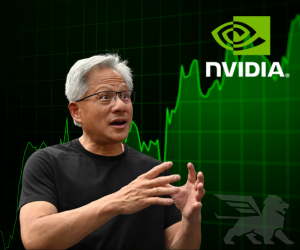WHAT HAPPENED TO NVIDIA STOCK
Nvidia just answered every “AI bubble” hot take with the loudest earnings print in market history. After a choppy few weeks of China headlines, policy jitters and options-driven selling, the company dropped Q3 FY2026 numbers that didn’t just beat—they obliterated expectations. Revenue jumped to $57.03B, Data Center hit $51.2B, non-GAAP gross margin held 75%, and Q4 guidance at ~$65B revenue effectively told bears to go hug their risk models. The stock ripped over 7% after hours, pushed pre-market above $153 and vaulted Nvidia’s market cap past $5T for the first time. Below, we stitch the full story together: the pre-print drawdown, the “all clear” quarter, and how this resets the narrative, the levels and the risk/reward heading into 2026–2027.

From drawdown to breakout
To really answer “what happened to Nvidia stock?” you have to stitch together two acts. Act I was the pre-earnings wobble: a $5 trillion milestone, a flurry of China and policy headlines, a wall of put buying and a November drawdown that had bears talking about “AI capex digestion.” Act II arrived on 19 November, when Nvidia detonated Q3 FY2026 expectations and turned that anxiety into a fresh $5T+ breakout. This first section recaps the set-up—the headlines, price levels and flows that got the stock from euphoria to doubt in the weeks before the print.
From $5 trillion Friday to pre-print nerves
In late October, Nvidia looked untouchable. The stock closed above a $5 trillion market cap for the first time, finished that week around $208 and printed a new all-time high a few sessions later as Reddit anointed it the “AI king forever.” Then the tape flipped. A South China Morning Post scoop about Beijing banning foreign AI chips in state data centres knocked a quick 4% off in early New York trading. A few hours later Reuters quoted the U.S. Commerce Department confirming Blackwell GPUs remained on the China export blacklist “at this time.” Fundamentals hadn’t changed overnight, but the narrative had—and in a crowded name, narrative is leverage.
Policy noise piled on. A Wall Street Journal headline quoted the Trump transition team as telling agencies there would be “no AI industry bailout, period.” At the same time, Nvidia’s own positive news—signing Samsung, Deutsche Telekom and Nokia to run 5G-AI on Blackwell—produced only a fleeting, 1% after-hours bounce that faded by the next close. The message was clear: good micro headlines were fighting a macro wall of worry, and the macro was winning.
Options flow, sector sympathy and the November slide
As headlines turned choppy, the options market quietly took control of the tape. Put volumes spiked, especially in short-dated strikes clustered in the high-$180s to low-$190s. Dealers who had sold those puts were pushed into classic negative gamma: as the stock fell, they sold more stock to hedge, which pushed it lower still. That dynamic turned modest news into exaggerated moves.
Then the rest of the AI complex started to crack. CNBC ran segments noting AMD, Broadcom and Marvell sliding 5–7% in a single session; basket-driven de-risking hit accelerators, networking and memory all at once. Nvidia, which had briefly kissed ~$212, found itself trading down through $192, then flirting with the high-$180s. By mid-November, the stock was down roughly 18% from its October high and around 8% for the month heading into earnings. The market was clearly braced for a “digestion” quarter: softer growth, cautious guidance and a narrative pivot from “unstoppable supercycle” to “OK, now we exhale.”
What everyone was afraid of
Heading into 19 November, the consensus story went something like this: the AI spending boom had been incredible, but physics was about to reassert itself. Chip export controls would bite China demand. Customers would pause orders ahead of Blackwell. New architectures would compress margins. Capex committees would discover words like “budget” again. The stock’s pre-print drift down to $144.86—a far cry from recent highs—reflected that fear, not a collapse in demand data.
Put differently, the market didn’t need a disaster to punish Nvidia; it just needed proof that the curve was flattening. Instead, it got the opposite.
The pre-earnings checklist
Positioning: heavy retail ownership plus systematic and options exposure made the name sensitive to narrative shocks.
Valuation: a $5T market cap baked in a decade of AI spend, raising the bar for every earnings print.
Macro & policy: export controls and shifting political rhetoric on AI added an extra risk premium layer.
Sector tape: sympathy selling across AI peers signalled broad de-risking, not just single-name doubt.
Expectations: the Street officially modelled strength, but whispers were already shading to “this might be the quarter growth slows.”
That’s the background. The real story—and why the stock exploded—starts when Nvidia opened its books on Q3 FY2026.
The earnings shockwave
On the evening of 19 November 2025, Nvidia didn’t just clear the bar the market had set—it raised the entire stadium. Q3 FY2026 was the “all clear” print for the AI supercycle: revenue, margins and guidance all came in stronger than feared, with commentary that explicitly dismantled the bear case line by line. This section walks through the numbers, the guidance and the call colour that turned an 8% November drawdown into a fresh $5T+ milestone overnight.
Q3 FY2026 by the numbers
Headline revenue hit $57.03 billion, up 62% year-on-year and 22% quarter-on-quarter. Street expectations sat in the roughly $54.8–$55.3B range, so Nvidia beat by about $2B at the midpoint—despite a lofty whisper number that had crept higher in recent weeks. In a $5T company, printing that kind of growth off that kind of base is almost unheard of; it effectively told investors that the AI demand wave is not just intact, it’s steepening.
Data Center—the engine that matters—delivered $51.2B in revenue, up 66% YoY and 25% QoQ, now contributing just under 90% of total sales (about 89.8%). Gaming, Automotive, and Professional Visualization still exist, but at this point they are rounding errors on the consolidated P&L. The market wanted proof that hyperscalers, enterprises and sovereigns were still building AI infrastructure at scale. These numbers were that proof.
On the profit side, non-GAAP EPS landed at $1.30, a $0.04–$0.05 beat versus consensus depending on your model. GAAP net income reached $31.92B, up roughly 65% YoY. Non-GAAP gross margin held an eye-watering 75.0%, flat versus last quarter and up about 160 bps YoY, even as the lower-initial-margin Blackwell architecture started to ramp. Operating expenses were a relatively modest $4.83B, up only 18% YoY, underscoring that operating leverage remains firmly in “god-tier” territory.
Guidance that rewrote the script
If the reported quarter was impressive, the guidance was the part that really made bears reach for their DeepSeek-R1 pillows. For Q4 FY2026, Nvidia guided revenue to $65.0B ±2%, implying a midpoint of about $65B—roughly 94% YoY growth and 14% QoQ. The Street had been sitting closer to $62.5–$63B. Nvidia didn’t just affirm the high bar that existed; it reset the bar higher again.
Implied Q4 Data Center revenue falls in the ~$59–60B range, versus analyst models clustered more around $56–57B. In practice, that means hyperscaler and enterprise demand is not just holding up—it’s compounding. Any lingering hope that AI capex would take a breather in late 2025 was, frankly, delusional in light of this guidance.
Jensen Huang dispensed with subtlety on the call: “Blackwell demand is off the charts.” “Cloud provider GPUs are sold out for the next 12 months.” “We are in full production ramp on Blackwell—expect billions in revenue this quarter and tens of billions next quarter.” Translated from CEO-speak into trader-speak: not only did the feared slowdown fail to materialise, but 2026–2027 spending now looks higher than almost anyone had pencilled in.
Blowing up the bear case
Heading into the print, the bear case rested on four pillars: China risk, pre-Blackwell order pauses, margin compression on new architectures, and the idea that AI capex was peaking. Nvidia’s commentary took a sledgehammer to each of them, live on the call.
China exposure: Management put China at roughly 5% of Data Center revenue—low single digits overall—making it directionally irrelevant to the big picture. Export rules matter tactically but not strategically.
“Pause before Blackwell”: Customers are not cancelling Hopper to wait for Blackwell; they are buying both. Deployment timelines and workloads mean overlap, not cannibalisation.
Margin fears: Despite ramping a new architecture, non-GAAP gross margin held flat at 75% QoQ and ticked higher YoY. Pricing power plus systems and software economics are more than offsetting any cost headwinds.
Capex “bubble” talk: With Q4 guided to ~94% YoY growth and commentary that 2026 spend will exceed 2025 for major hyperscalers, the notion of an imminent spending cliff looks badly out of step with reality.
Sovereign AI, systems and the order book
Beyond the core numbers, the qualitative colour on the call was almost as explosive. Sovereign AI—a catch-all for governments and national programmes building their own AI infrastructure—has already become a $20B+ annualised pipeline, up from roughly $10B just a quarter ago. Full Blackwell systems, including NVL72 and NVL144 racks, are reportedly sold out through most of 2026. That is not a normal supply/demand dynamic; that is scarcity pricing territory.
Jensen also name-checked marquee customers in a way that made the Street sit up. Meta has ordered another ~350,000 Blackwell GPUs for delivery in 2026. Tesla’s Dojo programme is buying Blackwell as well, with Elon Musk confirming on the call that he expects to spend $3–4B with Nvidia next year. Grace-Blackwell superchips are already shipping to every major cloud provider. In aggregate, this is what an entrenched platform looks like: Nvidia is not just selling chips; it is selling the de facto standard stack for accelerated computing.
How the stock reacted
The tape’s verdict was immediate. Nvidia closed regular trading on 19 November at $144.86, already up nicely on the session but still carrying the scar of its November drawdown. In after-hours trading, the stock ripped as much as 7.1%, hitting an extended-hours peak around $155.18. By pre-market the next morning, it was changing hands in the $153–$154 zone, up roughly 6–6.5% versus the close.
More importantly for the narrative, Nvidia’s market cap crossed $5 trillion again—this time on the back of fresh, hard numbers rather than extrapolated hope—touching roughly $5.07T in early trading. The November drawdown (about −8% into the print, roughly −18% from the October high) was effectively erased in a single session. Classic Nvidia: compress into the event, then re-rate violently on the release.
Five stats that changed everything
$57.03B total Q3 revenue, +62% YoY / +22% QoQ, roughly $2B ahead of consensus.
$51.2B Data Center revenue, +66% YoY / +25% QoQ, now ~90% of total sales.
Non-GAAP gross margin of 75.0%, flat QoQ and up ~160 bps YoY despite Blackwell ramping.
$65B ±2% Q4 revenue guide (~94% YoY, ~14% QoQ), ahead of Street by several billion dollars.
$5T+ market cap confirmed again, now backed by realised earnings power rather than just story.
This wasn’t a “we muddled through” quarter. It was an acceleration. That’s the crucial distinction as we think about what comes next.
What it means now
With the dust still settling on Q3 FY2026, “what happened to Nvidia stock?” now has a very different answer than it did a week ago. A fear-driven pre-earnings slide was met with one of the strongest large-cap earnings beats in market history, followed by a sharp re-rating that put Nvidia firmly back above the $5T line. This final section focuses on implications: how the print reshapes the AI capex narrative, what levels and scenarios traders are likely to anchor to, and how different types of investors might frame risk from here—always with the caveat that none of this is personalised advice.
The AI supercycle, upgraded
Before this quarter, you could argue that the AI infrastructure boom was powerful but fragile—a story built on hyperscaler budgets that might pause, on export regimes that might tighten, on capex committees that might rediscover gravity. After this quarter, that argument is materially weaker. Hyperscalers are not just maintaining spend; they are accelerating into 2026. Sovereign AI has doubled its pipeline in a single quarter. Full-rack Blackwell systems are sold out for most of 2026. Those are not the footprints of a bubble that has already popped; they are what the middle innings of a capex supercycle look like.
Crucially, Nvidia’s economics still scale beautifully with that demand. Gross margins remain in the mid-70s, operating expenses are growing slower than revenue, and the company is layering systems, software and full-stack solutions on top of raw silicon. That means each incremental dollar of Data Center revenue is not just big; it is profitable. If Blackwell margins do in fact surprise to the upside—as Jensen hinted they might—then the long-run earnings power implied by this quarter is higher than most pre-print models assumed.
Short-term tape, medium-term scenarios
In the near term, the conversation naturally shifts to levels. With the stock ripping into the mid-$150s after hours and flirting with that zone pre-market, the market is already toying with a $160–$170 range as a plausible short-term magnet—especially if options dealers, now short gamma to the upside, are forced to chase. Looking a bit further out, a move toward $200+ by the next earnings print is no longer a meme-only talking point; it is a realistic scenario path if (and it is an if) Blackwell ramps as guided and margins stay firm.
None of that is guaranteed, of course. Macro shocks, fresh regulation, supply hiccups or competitive surprises could all derail the glidepath. But the base case in the market’s mind has shifted from “the top might be in” to “the trend is stronger and longer than expected.” That is a very different default setting for multiples and flows.
A practical, non-delusional playbook
Given the new information, how might different players think about Nvidia—without cosplaying as clairvoyants?
Long-term fundamental investors: Treat Q3/Q4 as confirmation that the AI infrastructure cycle extends through at least 2026–2027 at high levels. Focus on unit volumes, backlog, supply constraints and software attach rather than tick-by-tick price action. Phase entries; don’t chase vertical candles.
Macro & sector allocators: Recognise that Nvidia has re-anchored the entire AI complex. Underweights in accelerators, networking and adjacent plays now carry more career risk. At the same time, concentration risk in a single $5T+ name is real; position sizing matters.
Options traders: Respect the new volatility regime. Post-print, skew and term structure will reflect both the upside chase and the reality that every earnings date is now a macro-style event. Structures like call spreads, calendar spreads or defined-risk upside bets may make more sense than naked wings.
Retail “buy the dip” crowd: This print just validated your thesis more than your timing. The risk is shifting from “is AI real?” to “how much air can a single stock carry in your portfolio?” Diversification is still a thing, even in a supercycle.
Risks that still matter
It’s tempting, after a quarter like this, to declare the game over and go full victory-lap. That would be a mistake. The print neutralised several near-term worries, but it did not make Nvidia invincible. Export controls can still tighten in unexpected ways. Competing architectures—from custom silicon at hyperscalers to rival accelerators—can chip away at wallet share on the margin. Supply chain bottlenecks in networking, cooling or power can delay deployments even when demand is robust.
There is also the simple arithmetic of size. At a $5T+ market cap, Nvidia doesn’t have to “fail” to deliver a rough ride; it just has to grow a little less explosively than the most optimistic scenarios assume. Multiple compression on slightly softer growth can hurt just as much as outright revenue misses. In that sense, risk management is not cancelled by a great quarter; if anything, it becomes more important as the stakes climb.
A fresh conclusion to the question
So, what happened to Nvidia stock? In the short version, it rode a classic sentiment cycle. First, a surge to a $5T milestone and fresh highs. Then, a headline- and options-driven drawdown that had investors debating whether the AI capex wave was finally topping. And finally, an earnings release that demolished that doubt with $57B of revenue, 75% gross margins, an insane Q4 guide and call colour that painted 2026–2027 as bigger, not smaller, years for AI spend.
In the longer, more structural sense, the stock just moved from “story with numbers” to “numbers with a story.” The AI supercycle is not only alive; it looks stronger and longer than the pre-print consensus assumed. That doesn’t mean straight-line price action, and it definitely doesn’t mean risk has vanished. But it does mean that, for now, the market has its answer. Nvidia didn’t just survive the digestion fears—it accelerated straight through them.








